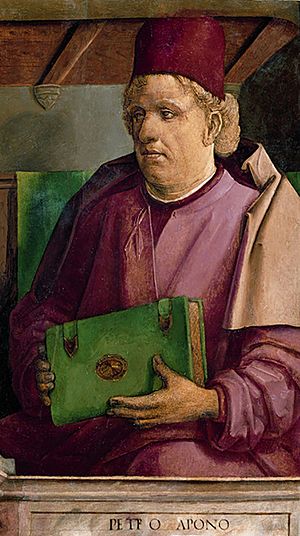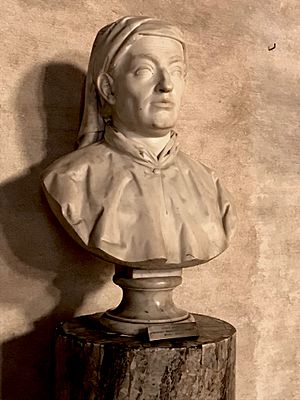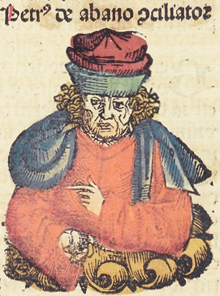Pietro d'Abano facts for kids
Quick facts for kids
Pietro d'Abano
|
|
|---|---|
 |
|
| Born | c. 1257 Abano Terme
|
| Died | c. 1315 Rome
|
| Nationality | Italian |
| Occupation | Philosopher Astrologer Physician |
Pietro d'Abano, also known as Petrus de Apono, Petrus Aponensis or Peter of Abano (c. 1257 – 1316), was an Italian philosopher, astrologer, and professor of medicine in Padua. He was born in the Italian town from which he takes his name, now Abano Terme. He gained fame by writing Conciliator Differentiarum, quae inter Philosophos et Medicos Versantur. He was eventually accused of heresy and atheism, and came before the Inquisition. He died in prison in 1315 (some sources say 1316) before the end of his trial.
Contents
Biography

He lived in Greece for a period of time before he moved and commenced his studies for a long time at Constantinople (between 1270 and 1290). Around 1300 he moved to Paris, where he was promoted to the degrees of doctor in philosophy and medicine, in the practice of which he was very successful, but his fees were remarkably high. In Paris he became known as "the Great Lombard". He settled at Padua, where he gained a reputation as a physician. In Padua he befriended an older scholar Paolo Tosetti. Also an astrologer, he was charged with practising magic: the particular accusations being that he brought back into his purse, by the aid of the devil, all the money he paid away, and that he possessed the philosopher's stone.
Gabriel Naudé, in his Antiquitate Scholae Medicae Parisiensis, gives the following account of him:
Let us next produce Peter de Apona, or Peter de Abano, called the Reconciler, on account of the famous book which he published during his residence in your university.
It is certain that physic lay buried in Italy, scarce known to any one, uncultivated and unadorned, till its tutelar genius, a villager of Apona, destined to free Italy from its barbarism and ignorance, as Camillus once freed Rome from the siege of the Gauls, made diligent enquiry in what part of the world polite literature was most happily cultivated, philosophy most subtilly handled, and physic taught with the greatest solidity and purity; and being assured that Paris alone laid claim to this honour, thither he presently flies; giving himself up wholly to her tutelage, he applied himself diligently to the mysteries of philosophy and medicine; obtained a degree and the laurel in both; and afterwards taught them both with great applause: and after a stay of many years, loaden with the wealth acquired among you, and, after having become the most famous philosopher, astrologer, physician, and mathematician of his time, returns to his own country, where, in the opinion of the judicious Scardeon, he was the first restorer of true philosophy and physic. Gratitude, therefore, calls upon you to acknowledge your obligations due to Michæl Angelus Blondus, a physician of Rome, who in the last century undertaking to publish the Conciliationes Physiognomicæ of your Aponensian doctor, and finding they had been composed at Paris, and in your university, chose to publish them in the name, and under the patronage, of your society.
He carried his enquiries so far into the occult sciences of abstruse and hidden nature, that, after having given most ample proofs, by his writings concerning physiognomy, geomancy, and palmistry, he moved on to the study of philosophy, physics, and astrology. These studies proved extremely advantageous to him. The first two led to his introduction to all the popes of his time and gained him a reputation among scholars. Beyond that, his mastery of astrology is shown by
- the astronomical figures he had painted in the great hall of the palace at Padua
- his translations of the books of the great learned rabbi Abraham Aben Ezra
- his own books on critical days
- the improvement of astronomy
- and the testimony of the renowned mathematician Regiomontanus, who praised his mastery of astrology in his public oration at Padua on Al-Farghani's masterwork Elements of astronomy on the celestial motions.}
Writings
In his writings he expounds and advocates the medical and philosophical systems of Averroes, Avicenna, and other Islamic writers. His best known works are the Conciliator differentiarum quae inter philosophos et medicos versantur and De venenis eorumque remediis, both of which are extant in dozens of manuscripts and various printed editions from the late fifteenth through sixteenth centuries. The former was an attempt to reconcile apparent contradictions between medical theory and Aristotelian natural philosophy, and was considered authoritative as late as the sixteenth century.
The famous grimoire called the Heptameron, though anonymous, has been traditionally attributed to Abano. The Heptameron is a concise book of ritual magical rites concerned with conjuring specific angels for the seven days of the week, whence the title derives. He is also credited with writing De venenis eorumque remediis, which expounded on Arab theories concerning superstitions, poisons and contagions.
The Inquisition
He was twice brought to trial by the Inquisition; on the first occasion he was acquitted, and he died before the second trial was completed. He was found guilty, however, and his body was ordered to be exhumed and burned; but a friend had secretly removed it, and the Inquisition had, therefore, to content itself with the public proclamation of its sentence and the burning of Abano in effigy.
According to Naude:
The general opinion of almost all authors is, that he was the greatest magician of his time; that by means of seven spirits, familiar, which he kept inclosed in chrystal, he had acquired the knowledge of the seven liberal arts, and that he had the art of causing the money he had made use of to return again into his pocket. He was accused of magic in the eightieth year of his age, and that dying in the year 1305, before his trial was over, he was condemned (as Castellan reports) to the fire; and that a bundle of straw, or osier, representing his person, was publicly burnt at Padua; that by so rigorous an example, and by the fear of incurring a like penalty, they might suppress the reading of three books which he had composed on this subject: the first of which is the noted Heptameron, or Magical Elements of Peter de Abano, Philosopher, now extant, and printed at the end of Agrippa's works; the second, that which Trithemius calls Elucidarium Necromanticum Petri de Abano; and a third, called by the same author Liber experimentorum mirabilium de Annulis secundem, 28 Mansiom Lunæ.
Barrett (p. 157) refers to the opinion that it was not on the score of magic that the Inquisition sentenced Pietro to death, but because he endeavoured to account for the wonderful effects in nature by the influences of the celestial bodies, not attributing them to angels or demons; so that heresy, rather than magic, in the form of opposition to the doctrine of spiritual beings, seems to have led to his persecution. To quote Barrett:
His body, being privately taken out of his grave by his friends, escaped the vigilance of the Inquisitors, who would have condemned it to be burnt. He was removed from place to place, and at last deposited in St. Augustin's Church, without epitaph, or any other mark of honor. His accusers ascribed inconsistent opinions to him; they charged him with being a magician, and yet with denying the existence of spirits. He had such an antipathy to milk, that seeing anyone take it made him vomit. He died about the year 1316 in the sixty-sixth year of his age.
See also
 In Spanish: Pietro d'Abano para niños
In Spanish: Pietro d'Abano para niños




